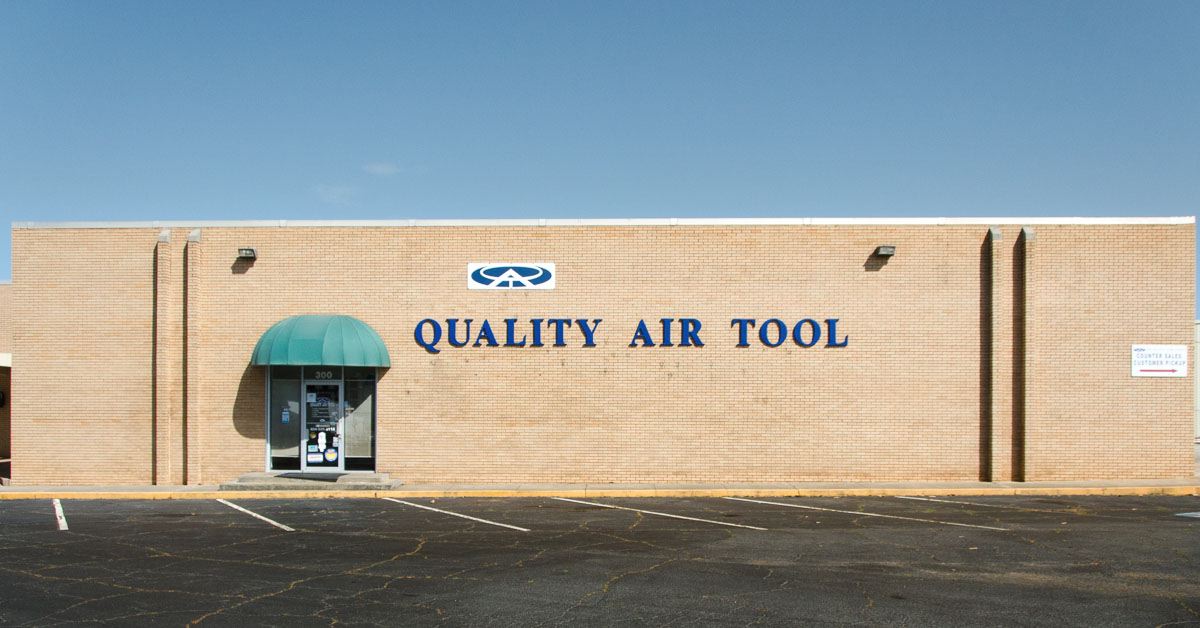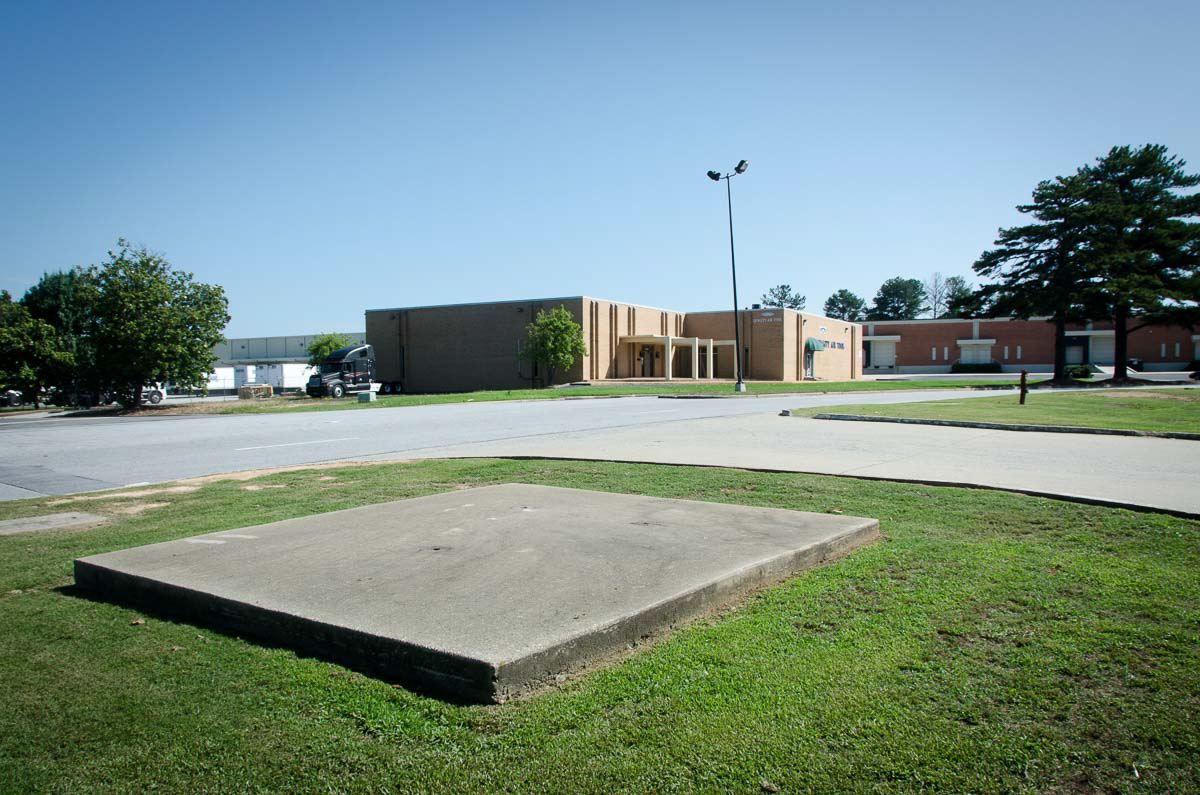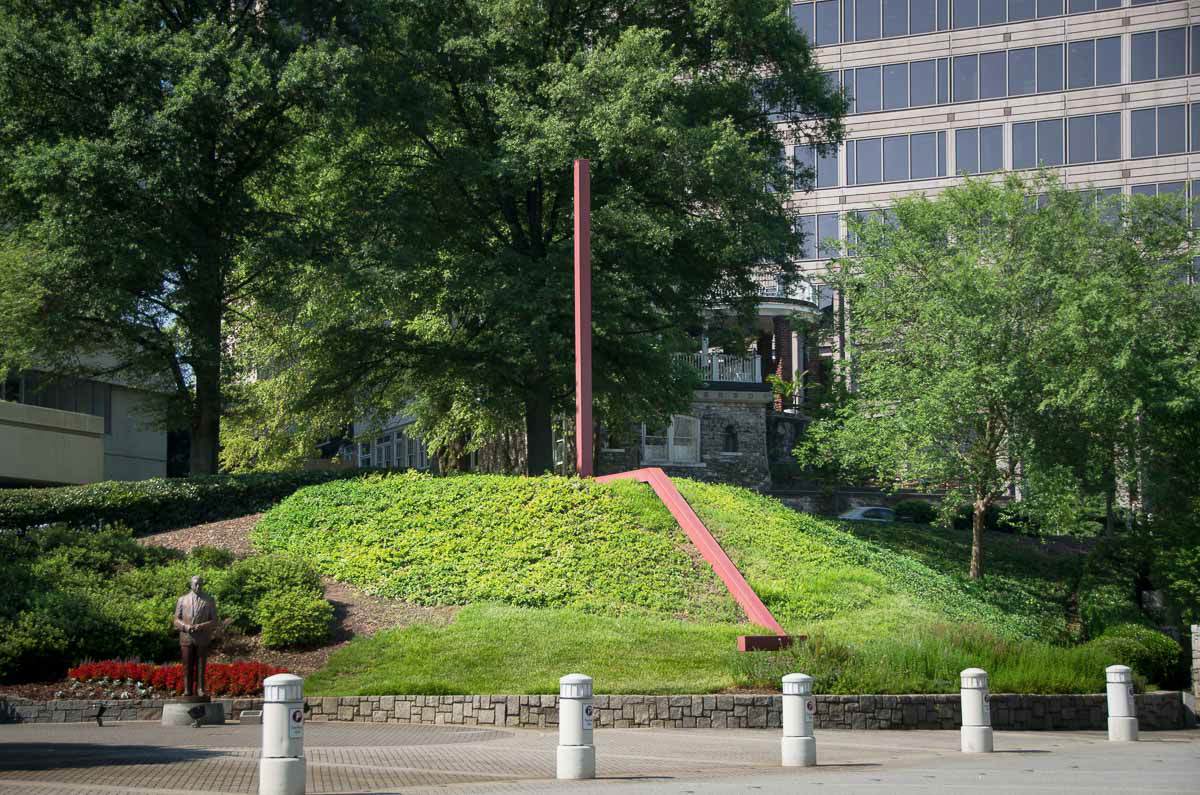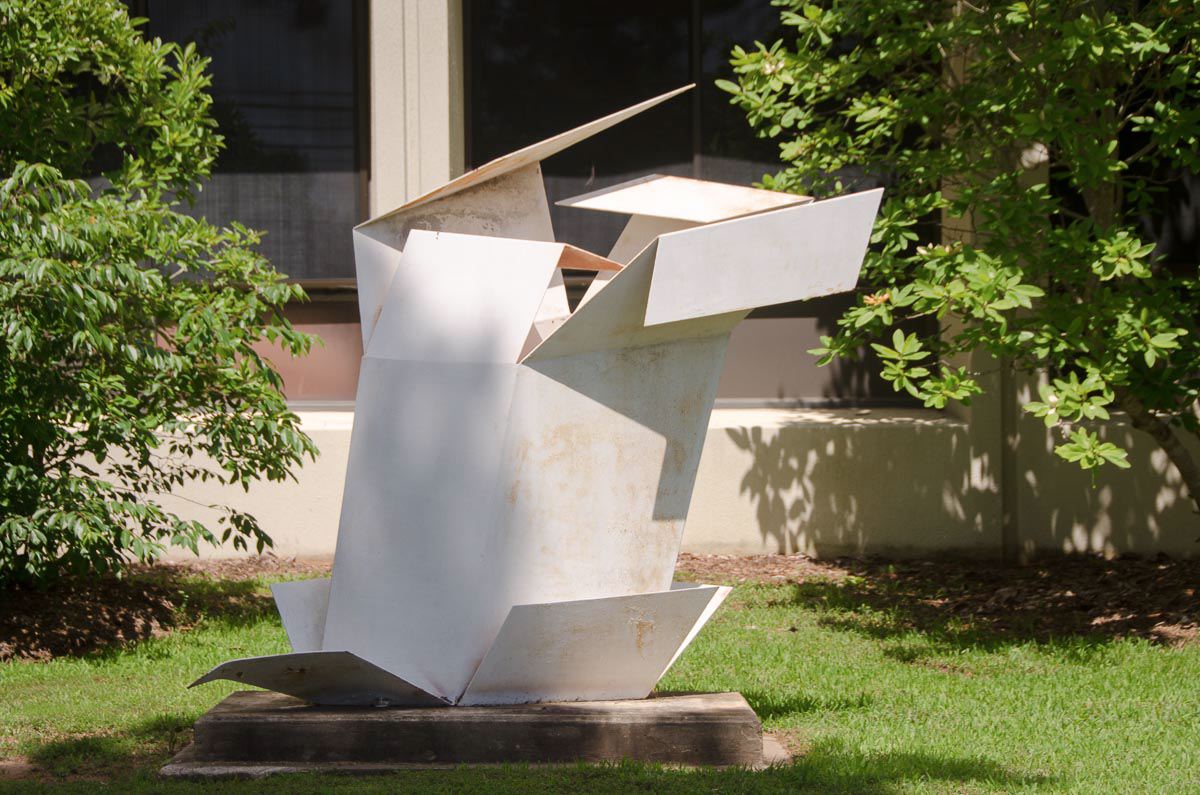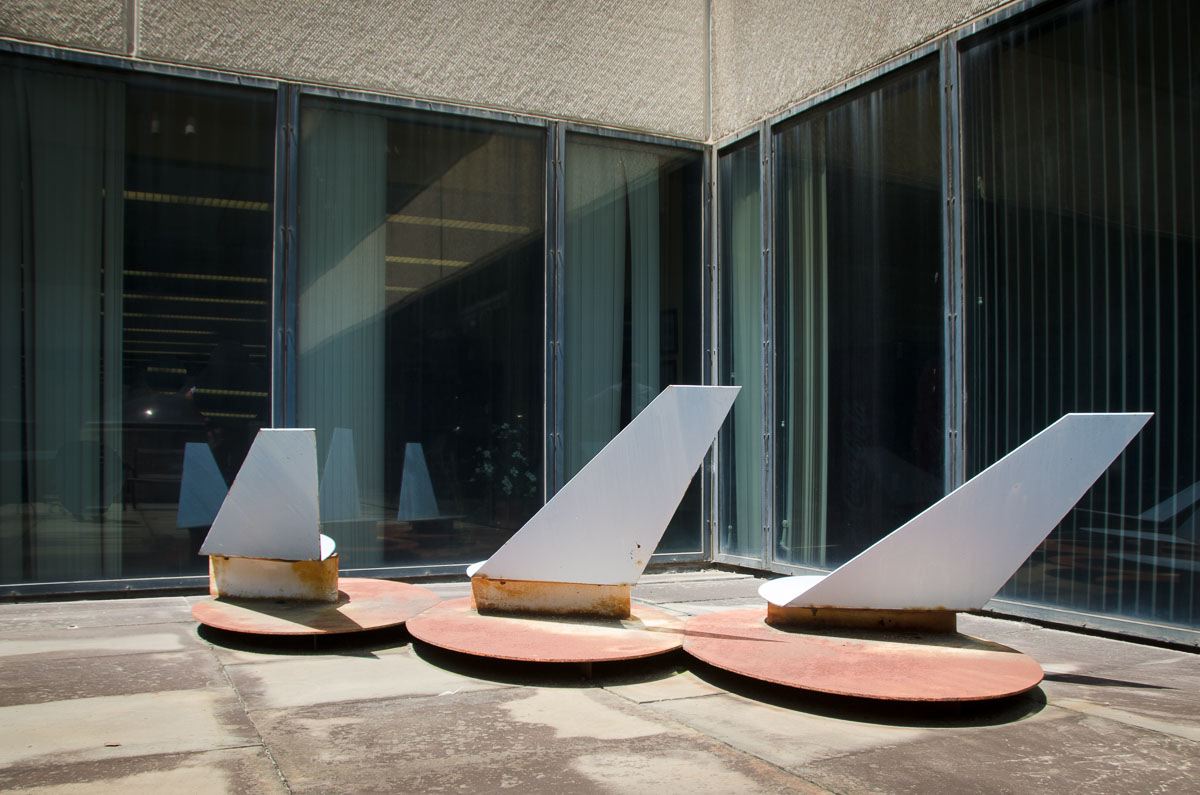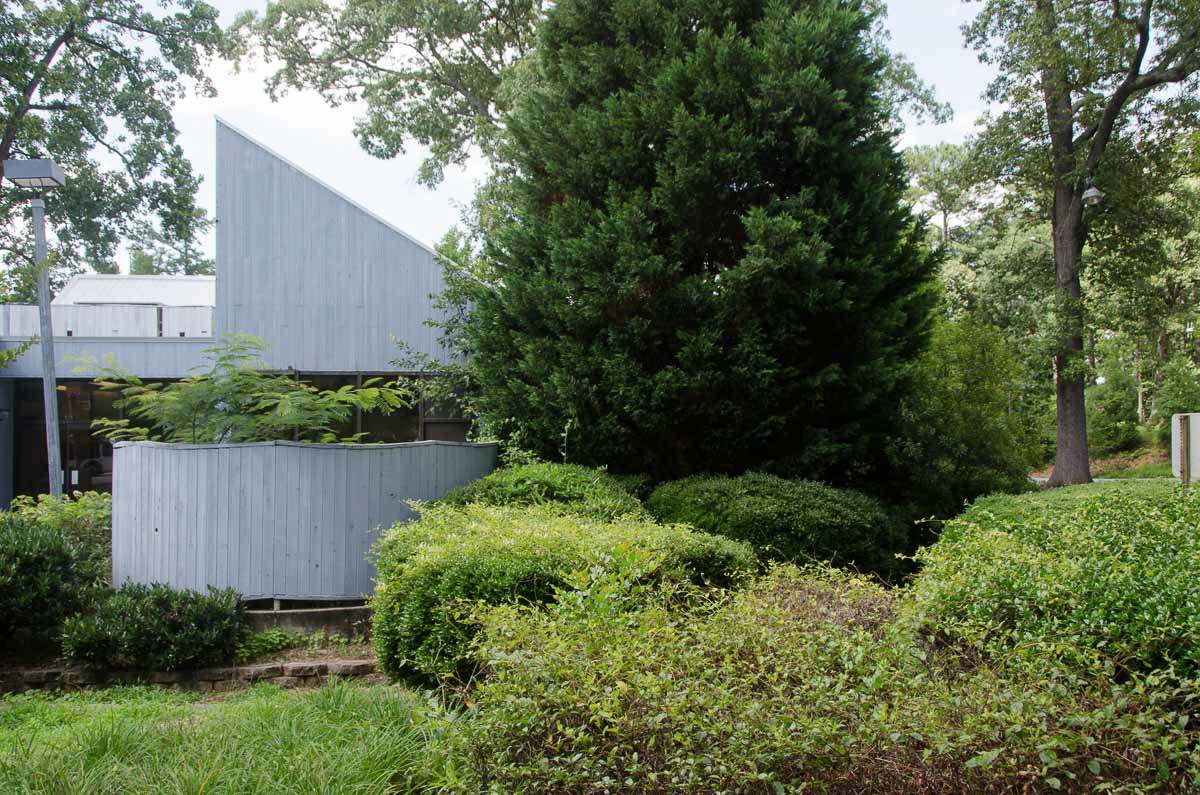Dead Ends
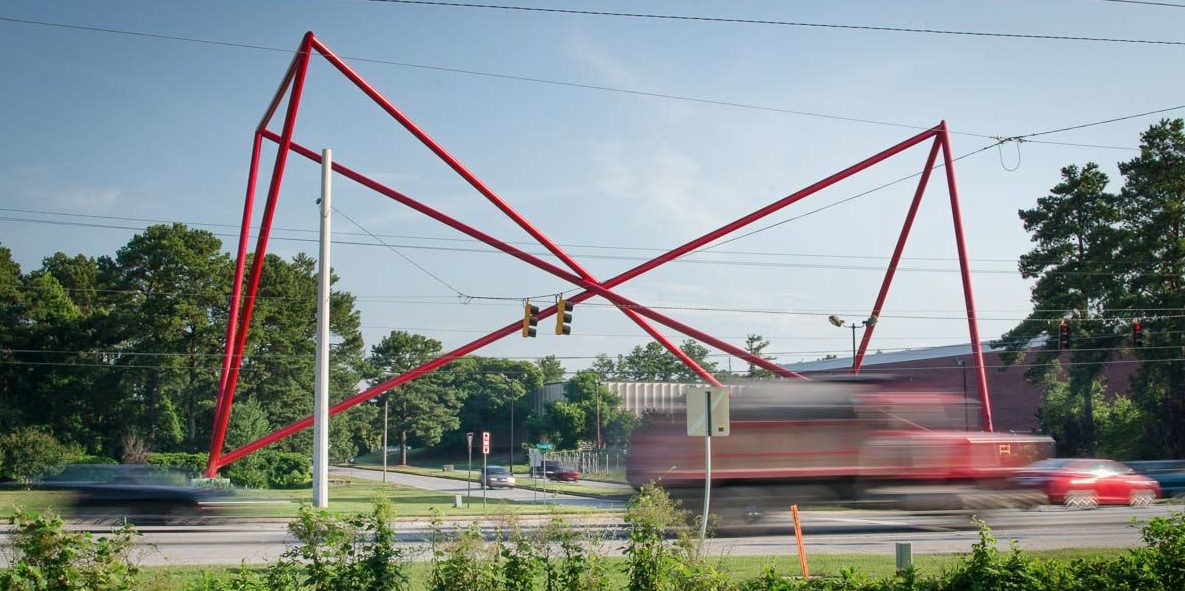
Peter Forakis, Atlanta Gateway (1967) at Atlanta Gateway Park, 2015 [photo: David Naugle]
As Atlanta struggles to foster an international cultural profile, disused plinths, installed decades ago, languish in an industrial park on the city's outskirts, once home to paragons of American postwar modernist sculpture. They are tombstones to an artistic legacy that got away, and reminders of how radically and urgently Atlanta's philosophy must change to begin to build upon even its former self.
Share:
The Z-Force came to Atlanta in 1988. It was a new kind of roller coaster, compact and knotted, with seven stories of twists and six vertical dives. This new addition to Six Flags Over Georgia created a memorable level of excitement and chatter: Atlanta schoolyards buzzed with stories of the g-forces that the ride inflicted on your body, and stories of kids who had lost consciousness or even died while on board. Despite the amusement park’s popularity as a talking point and as a summer destination, I would hazard a guess to say that no one among us was aware of its birth twin and intended partner in tourism: the Great Southwest Industrial Park, located just the other side of the Chattahoochee River. In the vision of Angus Wynne Jr., the man who founded both attractions, crowds would come to Six Flags for the adrenaline rush and then go to Great Southwest Industrial for the culture. When the latter park opened in November 1968, Atlanta had what was once described here in ART PAPERS as “the largest public collection of monumental contemporary sculpture in the world.”1 Now under the name Atlanta Gateway Park, the site remains home to only one of its original sculptures, and few visitors or locals seem aware that this “who’s who” of 1960s minimalism ever existed.
“Instead of an industrial slum growing just anywhere, deteriorating even as it is born, the Industrial Park is conceived as a center of industry in terms of reason and beauty,” wrote artist Dorothy Dehner in a 1969 text describing the production of her Plexiglas work Relief (1967), built for the site. Dehner noted that “It becomes a place to be admired rather than an unsightly complex to be avoided.”2 From its documentation, Dehner’s relief appears to have been a spread of circles and rectangles, resembling a set of wildly arranged, oversized punctuation marks. As with many of the works commissioned for the park, the whereabouts or ultimate fate of Relief is unknown today. The pale brick wall that previously supported the work now holds the sign for a company called Quality Air Tool, while underneath it, the rusted marks left behind by the nails formerly used to mount the sculpture are still visible.
Quality Air Tool facade, original location of Dorothy Dehner, Relief (1967) [photo: David Naugle]
The site is now solely and unmistakably an industrial park; its atmosphere is precisely as Dehner described it wouldn’t be. Trucks zoom along wide, empty roads to the Publix supermarket and FedEx depots there. Many of the buildings are boarded up amid mostly empty parking lots. The layers of the years are apparent: outlines of signage for companies once headquartered in the park are still traced on some of its nondescript façades, and train tracks overgrown with vegetation remain visible in parts of the site. Before the area was leveled to build the park, it had been part of Sandtown, an early settlement for the mix of Native Americans that the English called Creek Indians, and later a plantation; what is now called the Rev. Bill Allison Memorial Cemetery, a potter’s field filled with unmarked graves, still sits on a hill next to the site. On the park’s curbsides and medians, service access points and storm drains dot the struggling grass, punctuated by an occasional empty concrete plinth. At the top of one T-junction is a small alcove where two twisted, rusting poles jut from a rectangular base. Elsewhere, a broad, low decommissioned plinth has been painted bright blue, with “650” stenciled in white on its side to mark the street number of the distribution warehouse that sits behind it.
Wynne, CEO of Great Southwest, had already founded Six Flags Over Texas when he decided to expand his success on the outskirts of Atlanta. Complementing the amusement park would be a new kind of business center, a place for commerce that was also a “museum without walls.” He hired notable consultants for the job: writer and curator Douglas MacAgy, who had been director at the Dallas Museum for Contemporary Arts, associate director at the National Endowment for the Arts, and an early supporter of Marcel Duchamp; and Bauhaus painter and educator Josef Albers, then living in New Haven, CT, who was called in as color and materials consultant for the buildings being erected on the site, and who would contribute one of its first sculptures. MacAgy, with the help of Atlanta’s High Museum’s director at the time, Gudmund Vigtel, selected a list of artists whose work reflected some of the most influential minimalist sculpture of the time, including Donald Judd, Sol Lewitt, Beverly Pepper, George Rickey, and Kenneth Snelson. The opening gala, during which guests were driven from sculpture to sculpture in the small electric trains used to bus visitors in the massive Six Flags parking lot, celebrated 31 of these and other artists’ sculptures—predominantly large, abstract shapes cast in steel. Apparently, several additional works were already in storage and ready for installation, and several hundred more had been commissioned for later inclusion.
Abandoned concrete plinths, Atlanta Gateway Park, 2015 [photo: David Naugle]
By 1971, however, Wynne had sold the property, though reports on what precipitated this decision differ. According to Emory University art historian John Howett, only 15 works were left by the time he published a piece in ART PAPERS on the subject in 1981, and many of the ones still standing had either been vandalized or they were rusting and peeling. Far from the “who’s who” it promised to be, the park had become a “dead place,” Howett wrote, “a cemetary [sic] of late sixties’ Minimalism.”3 According to the article, the owner of the property at the time was a Milwaukee company called Mortgage Guarantee Insurance Corporation (MGIC), which apparently removed five sculptures and donated them to the Milwaukee Art Museum; several other works had been bought by the Atlanta gallerist Leonard Aronson. The failure of the park, for Howett, was hard evidence of corporate neglect. He condemned the private sector, ending his report with an impassioned plea: “Save the Atlanta Gateway Park Sculpture survivors! Or at least go out to see them—and weep with the dead.” A short follow-up by Chris Bratton appeared in this publication a few months later and was equally damning of “corporate non-responsibility.”4 It was also mildly optimistic, stating that the owners at that time, along with the Fulton County board, had agreed to “distribute the work to deserving institutions throughout Fulton County.” Bratton’s was the last widely published account of the Atlanta Gateway Park from this period.
The sole remaining sculpture at the site is hard to miss. More than 200 feet wide and 100 feet tall, it’s still one of the largest pieces of outdoor sculpture in the world. I stumbled onto it only accidentally, online, while following a thread from Robert Smithson’s writings on New York’s Park Place Group and its members’ use of Buckminster Fuller’s ideas. What came up was a gigantic pair of tetrahedrons by Park Place co-founder Peter Forakis, along with the name Atlanta Gateway (1967)—a sculpture in my hometown that I had never seen, and an apparent part of an entire sculpture park that I’d never heard of. Seen in person, Atlanta Gateway is impressive and awesome, a framework made up of three red tubular steel poles that meet above the road to outline two floating Platonic solids and dwarf the trucks coming and going beneath them. Pictures from the park’s early days show the work’s westernmost base surrounded by a pond with half a dozen fountains of water spurting up around it. Now all that’s there is another dried-out lawn typical of many Atlanta neighborhoods. The fact that the Forakis is still there at all seems more likely due to the prohibitive costs of moving it than anything else.
Locating the works that were removed from the area at some point after 1981 is hardly a walk in the park. MGIC no longer owns the site but still keeps a regional office in Atlanta; it has no records from its dealings with the park. The Milwaukee Art Museum confirmed that the works donated by MGIC were de-accessioned from its collection in 2011, that two of them sold through auction houses, and that the remaining three were transferred to the Lynden Sculpture Garden, a private family collection just outside Milwaukee that opened to the public in 2009. The High Museum confirmed that three sculptures from the park did become a part of its permanent collection, via negotiations made through Aronson. They include a kinetic sculpture by George Rickey, which has since been sold; a large set of steel beams by Will Insley, which the High still owns but has never put on display; and Tal Streeter’s Red (River Queen) (1973), which was moved directly from the park to its current home at the southeast corner of Atlanta’s Woodruff Arts Center, at Peachtree and 14th streets.
Tal Streeter, Red (River Queen) (1973), at Woodruff Arts Center, Atlanta [photo: David Naugle]
Aronson ran a gallery in Atlanta in the 1970s and 80s, and now lives in Tennessee, where he is still active as an occasional art adviser. He was called upon in 1972 to help salvage what he could from the park. “At first it was halfhearted, as I didn’t want to partake in the dismembering of what was going on there,” Aronson told me.5 “It was a sad affair; it started off really a very energetic and forward-looking manner of handling really great art, and it just went to pieces.” Over the course of three years, Aronson worked with Vigtel and several Atlanta-based collectors, donors, and developers, and managed to find homes for five sculptures. In addition to the three that went to the High, two went to an Atlanta property developer—namely, a large work by Doris Chase, and a set of steel cubes by Donald Judd. “I can recall renting some pretty huge cranes in order to move those pieces,” Aronson said. “We had to get these sculptures away from there because they were just going to be ruined; they were just going to dump them for people who dealt in metal by the pound. With the Judd piece, the people … I was dealing with thought that it was part of an air conditioning unit, and they were hesitant to sell it because they didn’t know which building it belonged to. They didn’t know who Donald Judd was. So I said, ‘Since it’s an air conditioning unit, I have all this equipment and I can get it out of your way,’ and they said, ‘Sure, we’ll throw it in.’” Both the Judd and the Chase were soon put on display as features of Atlanta properties, but the Chase was later destroyed in a storm, and the Judd has since disappeared from records.
Despite these efforts, several works were left to the elements. Bratton’s report was published alongside a set of “before and after” images of British artist David Hall’s Second Box (1965). Known primarily as a video artist, Hall’s sculptural contribution looked like an open cardboard box, its flaps angled as though blowing in the wind. The “after” image shows the work’s surface to have been rusted and stained, with its paint swelling or simply gone (Howett had already noted in his article that the sculpture had become a regular flyposting point for Communist Party notices). Yet Hall’s box is now restored, and it sits outside Fulton County’s South Service Center—a testament to the reality of at least some of the progress suggested in Bratton’s report. The angular, oversized chain-linked panels of Robert Murray’s Montauk (1967) can be found by the clubhouse at the Adams Park branch of the Atlanta-Fulton Public Library. Local sculpture aficionados can also track down a Ted Chatham at the Northside branch, an Anthony Magar at the Hapeville branch, and a seemingly anonymous work at the county’s North Service Center. The three low shark fin shapes of Isaac Witkin’s Skate (1967) are in a rusted and worse-for-wear state at Atlanta’s Central Library.
This list accounts for only 17 of the works produced for the park’s opening; the remaining 14, at the very least, have been left to the scrap heap of history. We might mourn those works from names we recognize, such as LeWitt’s A-7 (1966), a white grid on the ground with the outline of a cube set in its center, or Albers’ Garden (1966), a set of rectangles made up of the sandstone, pebbledash, and brick materials he had chosen for the park’s buildings. Yet other great losses are the achievements of individuals less renowned—artists such as Forrest Myers and Jack Krueger, who are still exhibiting, or Dorothy Berge, Toshio Odate, Duayne Hatchett, Peter Reginato, Mon Levinson, and Dassos Daphnis, all of whom were represented in some form even in 1981, and whose singular contributions are now simply gone.
David Hall, Second Box (1965) at South Fulton County Government Service Center [photo: David Naugle]
The reasons for the sculpture park’s progressive decline are perhaps not too surprising: its negligence was not so much the product of ignorance as it was of conceptions of land and business development that viewed—and in Atlanta, as elsewhere, continue to view—art and artists as unnecessary expenses or liabilities. Yet what is particularly striking is that hardly anyone remembers this cultural endeavor in the first place. The past, however eroded it may be, is not the jurisdiction of historians alone: its preservation is necessary to help communities understand the conditions and responsibilities of cultural production in the present, and going forward. Although the Atlanta Gateway was a private concern, it was nonetheless intended for a public—one that, unlike Six Flags’ consistent and enthusiastic audience, never materialized.
The city—its officials, its developers, and to lesser degree its inhabitants—might be held accountable for this collective failure to fully embrace and engage with the park. Decades after his ART PAPERS contribution, Bratton, now president of the School of the Museum of Fine Arts Boston, reflected to me that, “It was a very good collection, and a real loss that now almost 35 years later seems bigger still.” Concern was felt acutely in the arts community at the time, due to what Bratton has described as the “triumphal march of privatization” experienced in the 1980s.6 If the sculpture park was symbolic of the growing impingement of corporate agendas on the cultural landscape described by Howett and Bratton, then what the current para-urban wasteland that is the Atlanta Gateway proves is that this corporate “march” is happy to trample right over culture; the story of the Great Southwest Industrial Park is merely the first step in what we can now describe as the comprehensive assimilation of the cultural sphere into private concerns. Particularly disappointing about the trajectory of the Atlanta Gateway is that it was built in a city that continues to seek wider recognition and support for forward-thinking visual arts on a national scale; rather than celebrating commissions from Donald Judd or Sol Lewitt, however, postcards from Atlanta showcase the commercial structures of the CNN Building or the World of Coca-Cola.
Isaac Witkin, Skate (1967) at the Central Library, Atlanta [photo: David Naugle]
It is pertinent that, even if the Gateway’s sculptures had been tended and added to, the site would never have resembled the bucolic, rolling urban oasis we have come to associate with the “park”; it is characteristic of Atlanta that the “industrial” side was always intended to dominate the development. It was designed as a space to be traversed by car, and the roadside sculptures were installed to be appreciated from a car window. Whether Wynne truly expected families to top off their days of thrill rides and funnel cakes with a spin around a few blocks of brightly colored steel sheets and geometrically arranged I-beams, his vision was ahead of its time in terms of what is now the common practice of using public sculpture as an insurance for the value of land. It is this detail, if anything, that has most likely driven recent developments and rejuvenation efforts within the park. The land has been split among multiple owners now, and no one person or entity can be held accountable for its fate; the plot that is home to Forakis’ Gateway, however, is under the guardianship of a nonprofit, and a community improvement district (CID) founded by property owners in the area has taken on the sculpture’s restoration. Over the years, it had faded to a pale pink, but in April 2015, it received a bright new coat of “Sunrise Red.”
With some remaining Gateway works ending up at the High, and others at county offices, another way to situate the cultural significance of the sculpture park on Fulton Industrial is not as a lost asset, but as a case study in the United States’ continued move toward an exclusively privately funded and owned cultural production, exhibition, and preservation. The expansive maw of the Forakis, and the ghost town of abandoned plinths and rusted bolts that it inhabits, are embodiments of the model’s precariousness.
Photo: David Naugle
Chris Fite-Wassilak is a writer and critic based in London. He is currently working on a book for Copy Press’ Common Intellectual series.
David Naugle is a photographer, digital media director, and native Atlantan. He helps folks tell their stories. Visit him at www.davidnaugle.com
References
| ↑1 | John Howett, “Reflections on the Tragedy of the Great Southwest Industrial Park,” ART PAPERS, Issue 5.05 (September-October, 1981): 6. |
|---|---|
| ↑2 | Dorothy Dehner, “Plexiglas Relief for the Great Southwest Industrial Park, Atlanta, Georgia, U.S.A.,” Leonardo, MIT Press, Vol. 2, No. 2 (1969): 171. |
| ↑3 | Howett, “Reflections on the Tragedy,” 6. |
| ↑4 | Chris Bratton, “Update: The Great Southwest Industrial Park Sculpture,” ART PAPERS, Issue 6.02 (January-February, 1982): 13. |
| ↑5 | Leonard Aronson in conversation with the author, March 2015. |
| ↑6 | Chris Bratton, email to the author, March 2015. |
